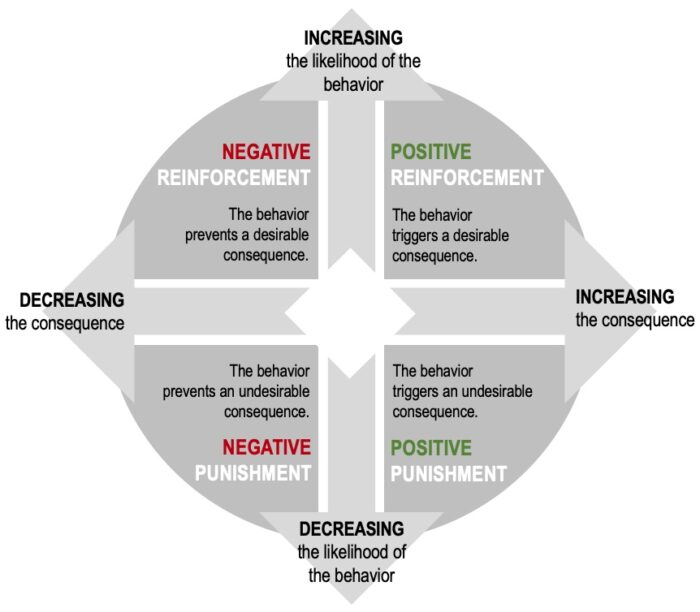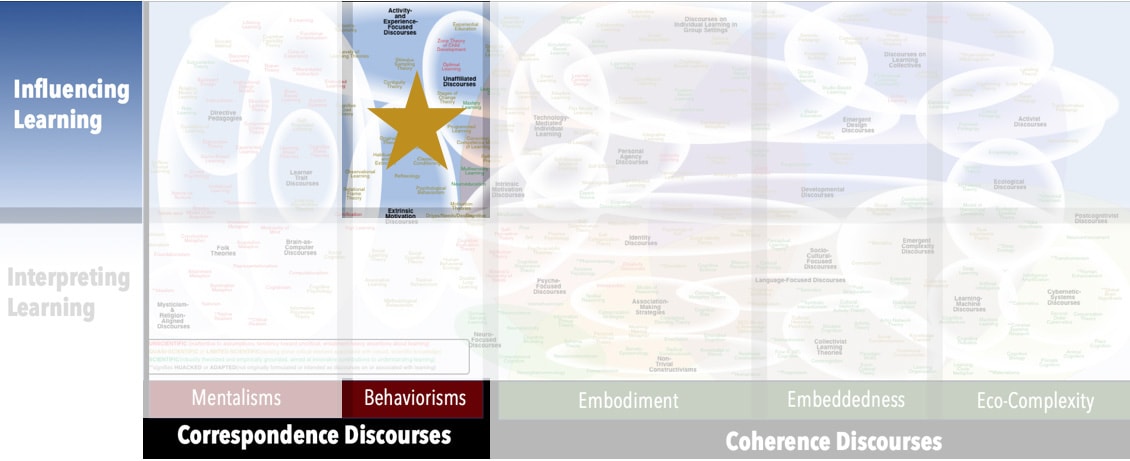AKA
Instrumental Conditioning
Instrumental Learning
Operant Learning
Reinforcement Theory
Type II Conditioning
Type R Conditioning
Focus
Affecting voluntary behaviors by manipulating environmental conditionsPrincipal Metaphors
Drawn from and/or aligned with principles from physics (Newtonian mechanics):- Knowledge is … repertoire of behaviors
- Knowing is … behaving (triggered by stimuli)
- Learner is … an organism
- Learning is … changes in behavior (linking stimuli to responses) due to changes in the environment
- Teaching is … conditioning (structures of reward and punishment that prompt changes in behavior)
Originated
1930sSynopsis
Operant Conditioning and Classical Conditioning are two branches of Behaviorisms that are more properly understood as advice on teaching than as theories of learning. Both are concerned with manipulating and managing behaviors controlled by environmental stimuli, although focusing on different categories of behavior and employing different methods. Operant Conditioning is concerned with non-reflexive, voluntary behaviors that are under the learners’ control (an "operant behaviour" is one that produces some sort of effect), and it deals with rewarding or punishing target behaviors to increase or decrease their manifestation:- Operant Behavior – in Operant Conditioning, the voluntary behavior that is intended to be influenced by conditioning. Associated notions include:
- Operant Level – the baseline (i.e., frequency) of an Operant Behavior when it is not being reinforced
- Terminal Behavior – the target of a planned conditioning program – that is, the intended nature and frequency of a target behavior after conditioning
- Operant Paradigm – the view that human behavior is principally controlled by the consequences of that behavior
- Discriminative Stimulus – in Operant Conditioning, the trigger – that is, the stimulus to which the organism responds. Associated constructs include:
- Cueing (Prompting) – in the context of Operant Conditioning, a Discriminative Stimulus offered by the teacher or trainer intended to signal the need for a desired behavior
- Setting Events – in the context of Operant Conditioning, ensuring the presence of an array of environmental conditions, any/all of which might serve as a Discriminative Stimulus for a desired behavior
- Respondent Behavior – in Operant Conditioning, the organism's behavior (that's triggered by a Discriminative Stimulus and followed by a Reinforcing Stimulus)
- Reinforcing Stimulus – in Operant Conditioning, the feedback – that is, the stimulus the organism receives after a behavior. Types include:
- Positive Reinforcement (Positive Reinforcer) – a Reinforcing Stimulus (i.e., something presented after a specific behavior is elicited) that increases the likelihood that behavior will be repeated
- Negative Reinforcement (Negative Reinforcer) – a Reinforcing Stimulus (i.e., something presented after a specific behavior is elicited) decreases the likelihood that behavior will be repeated
- Reinforcement Schedule – Reinforcing Stimuli can be administered according to different schedules, to different effects. Types include:
- Continuous Reinforcement – every desired response is reinforced
- Intermittent Reinforcement (Partial Reinforcement) – some, but not all desired responses are reinforced – purported to better reflect real life whereby desired behaviors are not reinforced every time. Types of Intermittent Reinforcement include:
- Fixed-Ratio Schedules – when the desired response is reinforced after a pre-specified number of responses, where that number is greater than one
- Variable-Ratio Schedules – when the desired response is reinforced seemingly randomly – that is, after an unpredictable number of responses
- Fixed-Interval Schedules – when a pre-specified stretch of time elapses before the desired response is rewarded
- Variable-Interval Schedules – when an unpredictable stretch of time elapses before the the desired response is rewarded
- Reward – either introducing Positive Reinforcement or withdrawing Negative Reinforcement after a specific behavior, for the purpose of increasing the likelihood that behavior will be repeated
- Punishment – either withdrawing Positive Reinforcement or introducing Negative Reinforcement after a specific behavior, for the purpose of decreasing the likelihood that behavior will be repeated.
- S–O Association – the association between the Discriminative Stimulus and the Reinforcing Stimulus
- Three-Term Contingency (ABCs of Behavior; Contingency Management) – the sequenced association of Antecedent stimulus, the Behavior, and the Consequence in Operant Conditioning. (Compare Two-Term Contingency of Classical Conditioning.)
 Precursors to Operant Conditioning included:
Precursors to Operant Conditioning included:
- Trial-and-Error Learning Theory (Edward Thorndike, 1890s) – a mode of learning through which a range of actions is tested until a satisfying outcome occurs. Trial-and-Error Learning Theory was an important precursor to Operant Conditioning for its realization that learning is promoted by positive consequences, which Thorndike formally articulated at the Law of Effect (see Behaviorisms). Associated constructs include:
- All-or-Nothing Learning – a conjecture that, in a single event, learning is either completed or does not happen at all (contrast: Incremental Learning; see above)
- Incremental Learning – learning that unfolds in small steps over time (contrast: All-or-Nothing Learning; see above)
- Puzzle Box (Thorndike Puzzle Box) (Edward Thorndike, 1890s) – a highly structured learning environment in which an organism must come across an action for a positive outcome – which was used to demonstrate that the time taken to manifest such actions tended to increase with the number of trials
- Law of Effect (Edward Thorndike, 1890s) – Actions associated with a satisfying result are more likely to be repeated under the same circumstances, and actions associated with an uncomfortable effect are less likely to be repeated.
- Discrimination Learning (Discriminative Learning) (Carl Lashley, 1920s) – within Behaviorisms, learning to respond differently to different triggers
- Avoidance Conditioning (Avoidance Learning) – learning how to elude or prevent an unwanted outcome. Types of avoidance behaviors include:
- Active Avoidance – engaging in a behavior that prevents an unwanted outcome
- Passive Avoidance – refraining from a behavior in order to avoid an unwanted outcome
- Errorless Learning (Charles Ferster, 1950s) – within Behaviorisms, a learning procedure that is sequenced and paced in a manner that minimizes the likelihood of undesired responses. It is based on the premise that errors impede learning (and, so, a learner’s errors are seen as a function of the teacher’s inadequate analysis of behavior)
- Escape Conditioning – learning how to terminate a persistent, unpleasant stimulus
- Fading – in Operant Conditioning, gradually reducing the intensity or frequency of prompts or reinforcements until the target behavior is maintained independently by the subject
- Free-Operant Conditioning (B.F. Skinner, 1930s) – a form of learning in which an organism can freely respond at any time, rather than only during discrete trials. The focus is on the rate of behavior as a function of its consequences (reinforcement or punishment).
- Precision Teaching (Ogden Lindsley, 1960s) – a systematic approach to instruction and intervention based on Free-Operant Conditioning that focuses on precise measurement and data-driven decision-making to improve learning outcomes
- Human Contingency Learning (Jan De Houwer, 1990s) – a probability-based, experimental approach to studying human learning that embraces foundational principles from both Classical Conditioning and Operant Conditioning, but that presses into topics of human cognitive processes. Its methods are focused on determining the extent to which (i.e., probability that) specific stimuli are related to specific responses.
- Learned Generalization (Secondary Generalization) (Roger Shepard, 1980s) – when an organism responds the same way to different stimuli with similar properties
- Omission Training (Differential Reinforcement of Other Behavior) – removing positive reinforcement when unwanted behavior occurs
- Operant Chamber (Skinner Box) – a highly structured learning environment in which an organism is rewarded for a specific response, enabling full control of the conditions of learning and great accuracy of counts and measures
- Probability Learning (William Glasser, 1970s) – an attempt to make sense of “choice” within a frame of Behaviorisms (i.e., ignoring mental processes), Probability Learning posits that behavioral choices are made according to the probabilities of their outcomes
- Shaping (Successive Approximation) –a process of teaching complex behaviors by rewarding spontaneous actions that initially approximate desired behaviors and, as things progress, that come closer and closer to desired behaviors
- Stimulus Discrimination (Clark Hull, 1940s) – learning to respond in a specific way to a Discriminative Stimulus that is very similar to a Discriminative Stimulus already associated with a learned response
- Stimulus Generalization (Clark Hull, 1940s) – associating a learned response with a Discriminative Stimulus that is different from the Discriminative Stimulus originally associated with the response
- Superstitious Behavior – a behavior that comes to be associated with a desired set of circumstances (and so is manifest more frequently) because it was random reinforced under those circumstances
- Time-Out – excluding the learner from a situation in order to stop the incidental reinforcement of an undesired behavior
- Visceral Learning – the use of Operant Conditioning techniques to affect nonconscious functions, such as heart rate. (Contrast with Autonomic Learning, under Classical Conditioning.)
Commentary
See Behaviorisms for global commentaries, especially as this theory relates to human learning. Three major critiques of Operant Conditioning in particular bear emphasis: Firstly, in recent decades it has become evident that Intrinsic Motivation Discourses (i.e., structures and dynamics that are not external to target behaviors) can be much more powerful for changing and maintaining behaviors than Extrinsic Motivation Discourses. Second, behaviors that are shaped by Operant Conditioning regimes of reward and punishment can be volatile and prone to regression and other distortions – indicating that the underlying metaphor of cognition (i.e., a network of cause–effect links) is not adequate, especially for higher-order functions. Thirdly, effective application of Operant Conditioning training techniques generally requires highly controlled situations with minimum distractions and maximum consistency in the rewarding and punishing of target behaviors. Such conditions simply cannot be achieved in a classroom setting.Authors and/or Prominent Influences
B.F. Skinner; Edward ThorndikeStatus as a Theory of Learning
Operant Conditioning is not a theory of learning, but advice for manipulating and managing behavior that arises from Behaviorisms.Status as a Theory of Teaching
Operant Conditioning is a more appropriately regarded as a theory of teaching than a theory of learning, and this fact was recognised in the mid-20th century when it rose to prominence in the field of education. With its focus on manipulating behavior, Operant Conditioning falls among mechanistic conceptions of teaching associated with Correspondence Discourses on learning.Status as a Scientific Theory
The foci, processes, and interpretations of Operant Conditioning are clearly articulated and supported by a substantial body of uncontradicted evidence.Subdiscourses:
- Active Avoidance
- All-or-Nothing Learning
- Avoidance Conditioning (Avoidance Learning)
- Continuous Reinforcement
- Cueing (Prompting)
- Discrimination Learning (Discriminative Learning)
- Discriminative Stimulus
- Errorless Learning
- Escape Conditioning
- Fading
- Fixed-Interval Schedules
- Fixed-Ratio Schedules
- Free-Operant Conditioning
- Human Contingency Learning
- Incremental Learning
- Intermittent Reinforcement (Partial Reinforcement)
- Law of Effect
- Learned Generalization (Secondary Generalization)
- Negative Reinforcement (Negative Reinforcer)
- Omission Training (Differential Reinforcement of Other Behavior)
- Operant Behavior
- Operant Chamber (Skinner Box)
- Operant Level
- Operant Paradigm
- Passive Avoidance
- Positive Reinforcement (Positive Reinforcer)
- Precision Teaching
- Probability Learning
- Punishment
- Puzzle Box (Thorndike Puzzle Box)
- Reinforcing Stimulus
- Respondent Behavior
- Reward
- S–O Association
- Setting Events
- Shaping (Successive Approximation)
- Stimulus Discrimination
- Stimulus Generalization
- Superstitious Behavior
- Terminal Behavior
- Three-Term Contingency (ABCs of Behavior; Contingency Management)
- Time-Out
- Trial-and-Error Learning Theory
- Variable-Interval Schedules
- Variable-Ratio Schedules
- Visceral Learning
Map Location

Please cite this article as:
Davis, B., & Francis, K. (2025). “Operant Conditioning” in Discourses on Learning in Education. https://learningdiscourses.com.
⇦ Back to Map
⇦ Back to List
